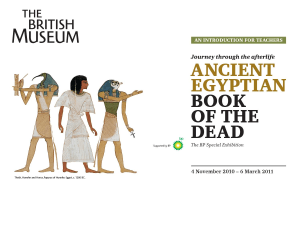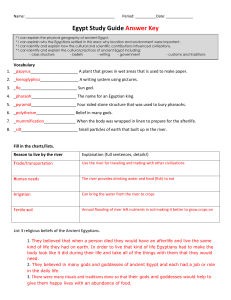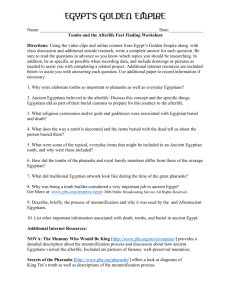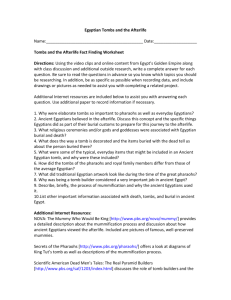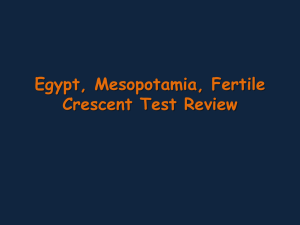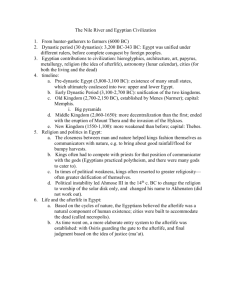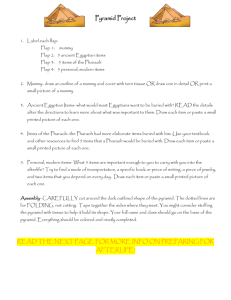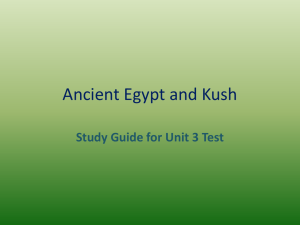Beginner`s Guide to The Book of the Dead
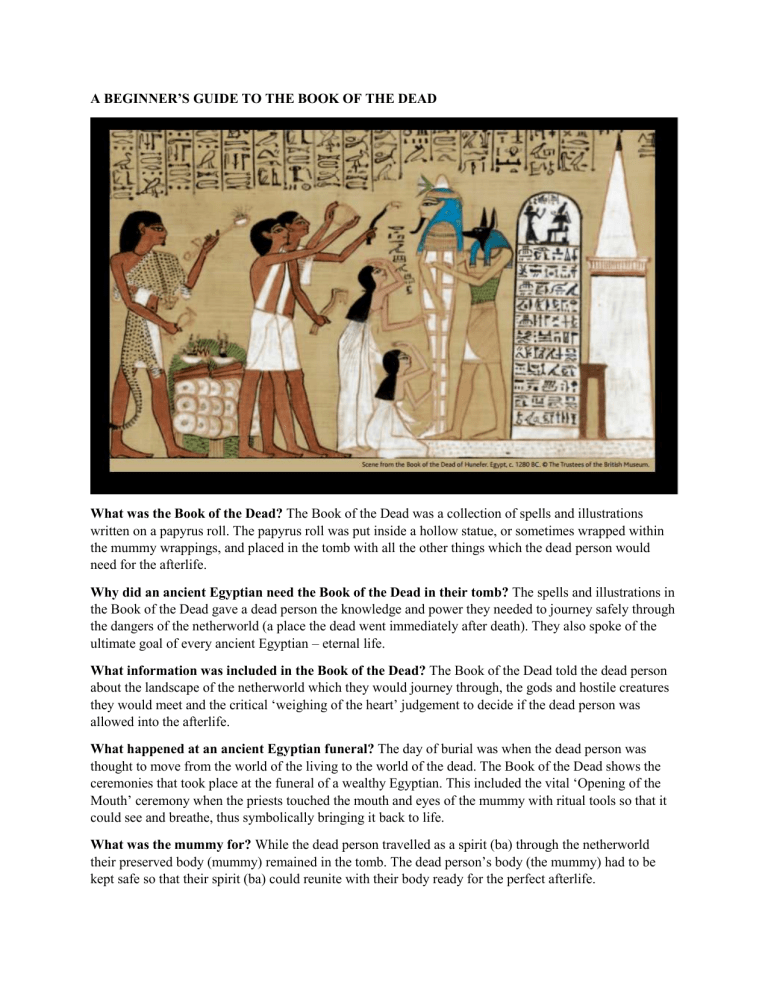
A BEGINNER’S GUIDE TO THE BOOK OF THE DEAD
What was the Book of the Dead?
The Book of the Dead was a collection of spells and illustrations written on a papyrus roll. The papyrus roll was put inside a hollow statue, or sometimes wrapped within the mummy wrappings, and placed in the tomb with all the other things which the dead person would need for the afterlife.
Why did an ancient Egyptian need the Book of the Dead in their tomb?
The spells and illustrations in the Book of the Dead gave a dead person the knowledge and power they needed to journey safely through the dangers of the netherworld (a place the dead went immediately after death). They also spoke of the ultimate goal of every ancient Egyptian – eternal life.
What information was included in the Book of the Dead?
The Book of the Dead told the dead person about the landscape of the netherworld which they would journey through, the gods and hostile creatures they would meet and the critical ‘weighing of the heart’ judgement to decide if the dead person was allowed into the afterlife.
What happened at an ancient Egyptian funeral?
The day of burial was when the dead person was thought to move from the world of the living to the world of the dead. The Book of the Dead shows the ceremonies that took place at the funeral of a wealthy Egyptian. This included the vital ‘Opening of the
Mouth’ ceremony when the priests touched the mouth and eyes of the mummy with ritual tools so that it could see and breathe, thus symbolically bringing it back to life.
What was the mummy for?
While the dead person travelled as a spirit (ba) through the netherworld their preserved body (mummy) remained in the tomb. The dead person’s body (the mummy) had to be kept safe so that their spirit (ba) could reunite with their body ready for the perfect afterlife.
What was the netherworld like?
The dead person travelled through a landscape with paths, rivers, mountains, caves, lakes and fields. On this journey they went through many gates and doors which were guarded by gods.
What special powers did the spells provide? Some spells gave the dead person the power to control their body and keep it safe. Some spells allowed the dead person to turn into different animals making it easier to travel through the netherworld. Some spells gave the dead person information which they would need to repeat at certain points on their journey. Some spells gave the dead person protection against hostile creatures.
How did an ancient Egyptian get into the afterlife?
The gods judged how the dead person had led their life to decide if they deserved to be given eternal life and enter the afterlife. The dead person’s heart was weighed on a set of scales against the feather of truth. If the scales showed the dead person was free from evil, they were declared ‘true of voice’ and admitted to the afterlife. If not, their heart would be eaten by the ‘Devourer’ monster and they would cease to exist – forever.
What was the afterlife like?
The perfect afterlife could be different for different people. The dead person might join the gods – worshipping Osiris or travelling with the sun god Ra. Or they might enter a pastoral paradise known as the Field of Reeds – a landscape like that of Egypt, with waterways to sail on and fields filled with crops to ensure that the dead never went hungry.
How was the Book of the Dead made?
Scribes and painters wrote out and illustrated the Book of the
Dead papyrus rolls. Sometimes most of the roll was already written and the tomb owner just had their own name and picture added in.
How long was the Book of the Dead used in ancient Egypt?
The Book of the Dead, used for about
1,500 years, is part of a tradition of providing religious texts for the dead. The earliest of these texts are found in Old Kingdom (about 2686–2181 BC) pyramids and were intended for dead kings. Over time texts for the dead became available to other members of the royal family, nobles and the middle classes.
At first texts were written on tomb walls. Later from about 2050 to 1750 BC they were carved on to coffins. The Book of the Dead developed from these coffin texts and has been found on coffins, shrouds, papyri and bandages. The most elaborate Books of the Dead were made during the New Kingdom period
(about 1550–1069 BC). It finally stopped being used as a funerary text in the first century BC.
What do we do with the Book of the Dead today?
Today experts study the Book of the Dead. They reconstruct fragments of papyri so that they can read them. Sometimes they discover pieces from the same papyrus roll in different museums. This gives museums new information. They work out what the ancient Egyptian thought happened to a person when they died. Conservators look after these fragile objects.
Have any complete Books of the Dead survived?
The Book of the Dead created for the ancient
Egyptian Nesitanebisheru is one of the largest surviving complete rolls. In the early 1900s it was cut into
96 separate sheets to make it easier to study, store and display. Today it is sometimes known as the
Greenfield Papyrus after Edith Mary Greenfield who donated the roll to the British Museum.
Crossing boundaries The ancient Egyptians believed that the cosmos consisted of the earth, the sky and a netherworld. They saw the movement of the sun, moon and stars, the annual flooding of the Nile and the growth of plants as evidence of an eternal cycle of life and believed that human existence could be renewed as part of this cycle. In eternal life Egyptians hoped to travel to the sky and netherworld – worlds inhabited by the gods – and revisit the world of the living. The perfect afterlife was a perfect version of the Egypt they had lived in, where they would be reunited with their families. To attain eternal life the body had to be preserved and the spirit aspects of the person, the ka and ba (see Glossary), had to be sustained.
Preparing for the afterlife The ancient Egyptians believed that the natural world of people and the supernatural world of the gods were closely interwoven. Magic and ritual were part of religious practices, used to overcome the challenges of everyday life, such as childbirth, sickness or injury. Magic was also used to enable the dead to reach the afterlife. It was invoked by pronouncing spells and performing special actions. The Book of the Dead was a collection of about 200 spells that helped the dead person to successfully face dangers and tests in the netherworld and achieve eternal life. A typical Book of the Dead manuscript would contain only a selection of these spells. The Egyptian name for this collection was the book of ‘coming forth by day’.
The landscape of the netherworld The deceased, in spirit form, had to journey through the world of the dead. The netherworld was thought to be beneath the earth (occasionally it was considered to be in the sky). Known as the Duat, it was regarded as a mysterious place, and was never mapped or described in a consistent manner. The dead person could travel on foot, by boat or through the air, in different physical
forms. The Book of the Dead contained information about features and beings in the netherworld including gateways, caverns and mounds, watched over by strange gods who had to be pacified. Safe passage could only be guaranteed with the sacred knowledge contained in the spells.
Empowering the dead Many spells in the Book of the Dead gave the dead person power to control the elements of their personality and the forces of nature. Spells prevented the decay of the body and the loss of the most essential parts – the head (the location of the identity and senses) and the heart (the location of the mind). Other spells sustained the non-physical parts of the person, the shadow, name and the ka and ba spirits. Some spells enabled the dead person to breathe, drink, control fire, freely move and travel in the sun god’s boat. One of the most important set of texts were ‘transformation spells’, allowing the dead person to turn into different forms such as a falcon, a heron, a swallow, a lotus flower, a snake or a crocodile. These forms gave the deceased free movement and special divine powers.
Avoiding disaster The Egyptians envisaged the netherworld as a place of many dangers. Many spells in the Book of the Dead gave the dead person the power to drive away snakes, crocodiles and insects. Others kept them safe from physical harm. Deities armed with snakes and knives ensured the dead person’s safety. They also guarded the homes of the living and watched over the dead in their tombs. One spell in the Book of the Dead describes gods who could repel enemies. Protective gods were painted on coffins and statues of them could be placed around the mummy to create a cordon of safety.
Judgement The greatest test which the dead person faced was the judgement in the Hall of the Two
Truths. Here the gods reviewed the dead person’s behaviour during their life, to decide whether or not they deserved to enter the afterlife. First the dead person addressed 42 deities by name, declaring to each that they were innocent of a specific offence such as theft or telling lies. The ancient Egyptians believed the heart was the centre of a person’s being and the location of their mind, so next the dead person’s heart was weighed against an image of Maat, the embodiment of order, right and truth. The heart could speak and so spells ensured that it did not reveal any damning facts about its owner. A perfect balance indicated a life well spent; the god Thoth returned the heart to its owner and declared them ‘true of voice’ before they were welcomed to paradise by the god Osiris. If the heart was heavier than Maat, its owner was condemned, their heart eaten by the monstrous Devourer and their existence ended. All copies of the
Book of the Dead show a successful outcome.
The perfect afterlife Different versions of the Book of the Dead contain different ideas about the afterlife. One view was that the mummy would remain resting in the tomb, in the underworld realm of
Osiris. In contrast, the ba spirit had the freedom to leave the body each day. The ba could revisit the world of the living, or travel with the sun god Ra in his boat. This meant the dead could share Ra’s rebirth each dawn and return to the tomb each night. Another view was that the dead person would exist in a place of paradise, the Field of Reeds. This was depicted in the Book of the Dead as a perfect Egypt – lush, well watered, fertile with abundant crops. This was a perfect version of Egypt and it is described in the Book of the Dead as the most desirable option.
Exploring the Book of the Dead A Book of the Dead papyrus was made by highly skilled scribes.
Usually more than one scribe worked on a papyrus. Sometimes spaces were left for another artist to add the images. The finest Book of the Dead papyri were written to order. Some papyri were made ahead, with blank spaces left for the eventual purchaser’s name. Thousands of Book of the Dead manuscripts have been discovered during the past 200 years and more continue to be found. These manuscripts are fragile and extremely sensitive to light. Scientific research is extending understanding of the materials used in their manufacture and helping to inform long-term preservation. New imaging technologies are revealing hidden or illegible texts. Specialist studies are highlighting patterns in the evolution of the Book
of the Dead, the methods of their production and the existence of different regional traditions.
Comparisons between different museum collections are revealing previously unsuspected links between fragments.
Nesitanebisheru’s Book of the Dead The Book of the Dead made for Nesitanebisheru (who died around
930 BC) is over 37 metres in length and is the longest known example. It contains a very large selection of spells, written in a precise hieratic hand and illustrated with exceptionally fine line drawings. Besides the traditional spells there are many which are not found in other manuscripts, and which may have been included at Nesitanebisheru’s personal request. Nesitanebisheru was the daughter of Pinedjem II, the high priest of Amun at the great religious centre of Thebes, and virtual ruler of Upper Egypt. She was one of the most powerful women of her time, and was buried in the ‘Royal Cache’ at Deir el-Bahri, the family tomb of the high priest, which also became the last resting place of the greatest pharaohs of the New
Kingdom. Today the papyrus is sometimes known as the Greenfield Papyrus after Edith Mary Greenfield who donated it to the British Museum in 1910.
Glossary
Afterlife The perfect afterlife lay at the end of the dead person’s journey through the netherworld. Here the dead person would enjoy eternal life alongside the gods.
Apotropaic Something, often an image or object, which will ward off evil forces or bad luck.
Ba Spirit of the dead person which left the physical body at death.
Book of the Dead Papyrus manuscript of written spells and magical images which would help the dead person journey through the netherworld to achieve the perfect afterlife.
Gods and goddesses Divine supernatural beings (deities) which the ancient Egyptians believed controlled their cosmos.
Hieroglyphs Signs used to write the ancient Egyptian language.
Mummy Artificially preserved body of a dead person.
Netherworld Realm of the dead which lay beneath the earth. A landscape of paths, rivers, mountains, lakes and fields with guarded gateways to pass and hostile creatures to avoid.
Papyrus A material made from the papyrus reed which grew in the marshes alongside the River Nile.
Thinly cut strips of the papyrus were pressed together and polished to create a smooth writing surface.
Spell Written incantations which gave the dead person power to control their body and successfully negotiate the dangers of the netherworld.
Tomb The place where the dead person’s mummy was placed. A tomb consisted of an open chamber for commemorating the dead person and leaving offerings (this space was often decorated with wall paintings and a statue of the dead) and a sealed burial chamber where the mummy and the burial goods were placed.
Vignette A picture on a papyrus manuscript.
